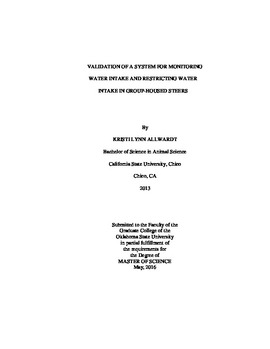| dc.contributor.advisor | Rolf, Megan | |
| dc.contributor.author | Allwardt, Kristi | |
| dc.date.accessioned | 2017-02-22T22:13:35Z | |
| dc.date.available | 2017-02-22T22:13:35Z | |
| dc.date.issued | 2016-05-01 | |
| dc.identifier.uri | https://hdl.handle.net/11244/49032 | |
| dc.description.abstract | The Insentec-RIC system was previously validated for the collection of water intake by Chapinal et al. (2007); however, this system has not been validated for the purposes of water restriction. The objective of this validation procedure was to evaluate the Insentec system as an appropriate tool for restricting water in beef cattle. A total of 239 crossbred steers were used in a 3 day validation trial which assessed intake values generated by the Insentec-RIC electronic intake monitoring system for both ad libitum water intake (n=122; BASE) and restricted water intake (n=117; RES). Direct human observations were collected on 4 Insentec water bins for 3 24-h periods and 3 12-h periods for BASE and RES, respectively. An intake event was noted by the observer when the electronic identification of the animal was read by the transponder and the gate lowered, and starting and ending bin weights were recorded for each intake event. Data from direct observations across each validation period were compared to total automated observations generated from the Insentec system. Missing beginning or ending weight values for visual observations occurred due to high bin activity and the observer was unable to capture the value before the monitor changed. To estimate the impact of these missing values, it was assumed that the missing beginning or ending weight was identical to that which was recorded by the Insentec system. Subsequent analyses will contain the data set containing missing values (OBSMISS) and the data set with assumed missing values (OBSNOMISS). Difference in mean total intake across BASE steers was 0.60 � 0.11 kg OBSMISS (0.40 � 0.09 kg OBSNOMISS) greater for system observations than visual observations. The comparison of mean total intake across the three RES validation days was 0.84 � 0.13 kg OBSMISS (0.44 � 0.11 kg OBSNOMISS) greater for system observations than direct observations (P<0.001). These results indicate that the system was capable of limiting water of individual animals with reasonable accuracy as compared to a restricted intake. The Insentec system is a suitable resource for monitoring individual water intake of growing, group-housed steers under ad libitum and restricted water conditions. | |
| dc.format | application/pdf | |
| dc.language | en_US | |
| dc.rights | Copyright is held by the author who has granted the Oklahoma State University Library the non-exclusive right to share this material in its institutional repository. Contact Digital Library Services at lib-dls@okstate.edu or 405-744-9161 for the permission policy on the use, reproduction or distribution of this material. | |
| dc.title | Validation of a System for Monitoring Water Intake and Restricting Water Intake in Group-housed Steers | |
| dc.contributor.committeeMember | Place, Sara | |
| dc.contributor.committeeMember | Krehbiel, Clint | |
| osu.filename | Allwardt_okstate_0664M_14469.pdf | |
| osu.accesstype | Open Access | |
| dc.description.department | Animal Science | |
| dc.type.genre | Thesis | |
| dc.type.material | text | |
